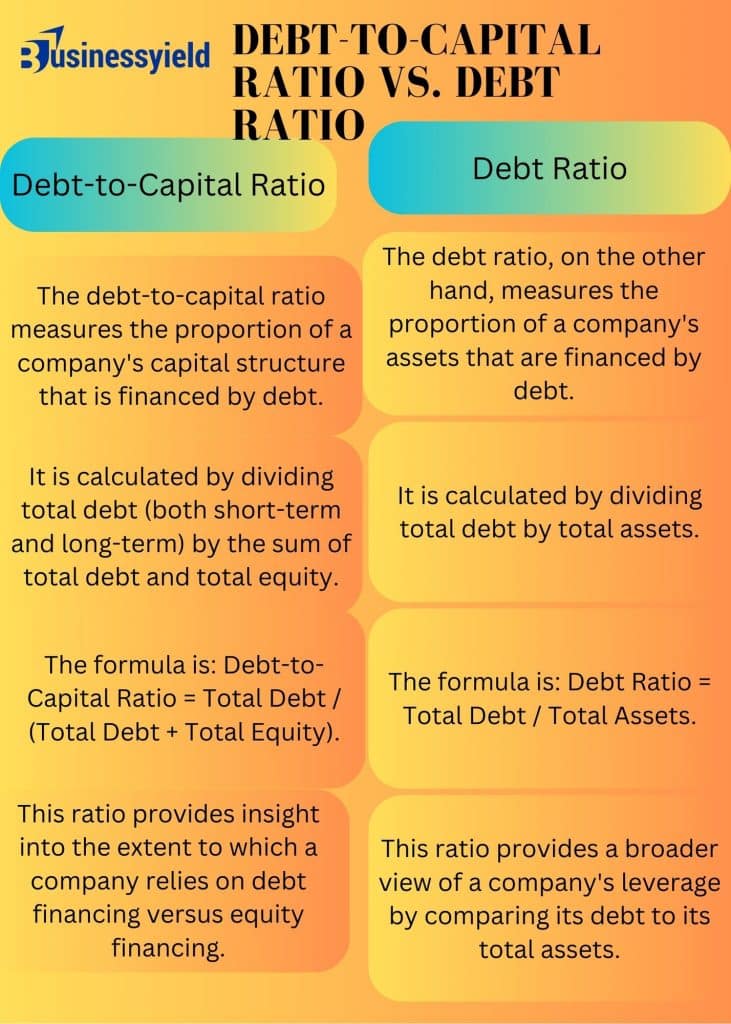For your financial assessment, you must understand the debt-to-capital ratio, which is crucial. Here, I will talk about debt-to-capital ratio, the debt-to-capital ratio formula, and How to Calculate the debt-to-capital ratio This detailed guide will provide valuable information about the debt-to-capital ratio formula and how to calculate it effectively. You will also have a solid grasp of this crucial financial metric and its significance in assessing a company’s financial health. I highly recommend going through this guide to understand this important aspect of financial analysis better. With my knowledge and experience in financial analysis, I can assure you that this guide will provide you with valuable insights into understanding and utilizing the debt-to-capital ratio effectively.
Understanding Debt to-Capital Ratio
The Debt to Capital Ratio is an important financial tool that helps you understand how a company manages its money and the risks it faces. It looks at how much of a company’s funding comes from borrowing compared to how much comes from investments by owners. If the ratio is high, the company relies a lot on borrowing, which can be risky because of the need to pay back loans and interest. On the other hand, a low ratio means the company is more careful about borrowing and relies more on investments from owners. Investors, lenders, and financial experts use this ratio to decide if a company is financially stable and can handle its debts in the long run.
Debt to Capital Ratio Formula
The formula for Debt to Capital Ratio is
Debt to Capital Ratio = Total Debt / (Total Debt + Total Equity)
The Debt-to-Capital Ratio is a measure that shows how much of a company’s funding comes from borrowing compared to total capital, which includes both borrowing and ownership. A high ratio means the company relies more on borrowing, while a low ratio means it leans more towards using its own resources. This ratio helps people who invest in or analyze companies understand how much risk the company has when it comes to borrowing money and dealing with financial challenges.
How to Calculate Debt to Capital Ratio
Here are a few ways you can calculate a debt-to-to-capital ratio
#1. Find Total Debt
Start by gathering information on all types of debt owed by the company. This includes short-term debts typically due within a year and long-term debts with a longer repayment period. Short-term debts may include accounts payable and short-term loans, while long-term debts may consist of bonds, mortgages, and long-term loans. Sum up the values of all these debts to get the total debt.
#2. Calculate Total Capital
Total capital represents the sum of all the funds used to finance the company’s operations. It includes both debt and equity components. To calculate total capital, you must add the total debt (which you calculated in Step 1) to the total equity. Total equity can be found on the company’s balance sheet and includes common stock, preferred stock, retained earnings, and additional paid-in capital.
#3. Apply the Formula
Once you have total debt and capital, you can apply the Debt-to-Capital Ratio formula. Divide the total debt by the total capital to get the ratio. This ratio expresses the proportion of the company’s capital that is financed by debt.
#4. Interpret the Result
After calculating the ratio, you’ll get a numerical value. This value indicates the percentage of the company’s capital structure comprised of debt. A higher ratio suggests the company relies more heavily on debt financing, which may indicate higher financial risk due to potential interest payments and debt obligations. Conversely, a lower ratio suggests a more conservative financial structure with less reliance on debt.
#5. Analyze and Compare
Analyzing the Debt-to-Capital Ratio in the context of the company’s industry norms, historical trends, and specific business models is essential. Comparing the ratio with industry peers and historical performance can provide insights into the company’s financial health and risk profile. Tracking changes in the ratio over time can help identify trends and potential shifts in the company’s capital structure and financial risk.
Checklist-on-Debt-to-Capital-Ratio-in-Financial- Assessment
What Is a Good Debt-To-Capital Ratio?
Generally, a lower ratio is often perceived as more favorable, indicating a conservative capital structure with less reliance on debt financing. However, what is considered acceptable can vary widely across industries. For example, capital-intensive industries such as utilities or telecommunications may have higher Debt to debt-to-capital ratios due to significant infrastructure investments.
As a guideline, a D/C ratio below 0.5 or 50% is often considered conservative and indicative of a financially stable company. Ratios between 0.5 and 0.7 may suggest moderate leverage. In contrast, ratios above 0.7 could indicate higher financial risk, particularly if accompanied by other indicators of financial distress, such as low profitability or liquidity issues.
When assessing a company’s risk profile, it’s crucial to consider its overall financial health, profitability, cash flow generation, and growth prospects alongside the D/C ratio. Additionally, comparing the ratio to industry peers and historical performance can provide valuable insights into whether the company’s capital structure aligns with industry norms and its own historical trends.
You might want to check out our article on Financial Risk Management: All you need to know (+Practical Examples)
What Is a Bad Debt-To-Capital Ratio?
A “bad” Debt-to-Capital Ratio typically indicates excessive reliance on debt financing, which may pose financial risks for the company. While what constitutes a “bad” ratio can vary depending on industry norms and specific circumstances, a high ratio relative to peers or historical performance is generally considered unfavourable.

Credit: wirestock
A Debt-to-Capital Ratio above 0.7 or 70% is often viewed as risky, especially if it is accompanied by other signs of financial distress, such as low profitability, liquidity problems, or high interest expense relative to earnings. Such a high ratio suggests that a significant portion of the company’s capital structure is funded by debt, potentially leading to increased interest payments and repayment obligations that could strain the company’s financial health.
A high debt-to-capital ratio may indicate the company has limited flexibility in coping with economic downturns, funding growth initiatives, or responding to unexpected challenges. It could also signal concerns for creditors and investors about the company’s ability to meet its debt obligations and maintain long-term sustainability.
However, it’s important to assess the it in the context of the company’s specific circumstances, including its industry, growth stage, and risk tolerance. Additionally, conducting a thorough analysis of other financial metrics alongside the D/C ratio can provide a more comprehensive understanding of the company’s overall financial health and risk profile.
Example of How to Use Debt-To-Capital Ratio
Let’s say we have a fictional company called XYZ Corp. To illustrate how to use it, let’s assume the following financial information for XYZ Corp:
- Total Debt: $2,000,000
- Total Equity: $3,000,000
Using this information, we can calculate the D/C ratio for XYZ Corp.
Debt-to-Capital Ratio=$2,000,000 $2,000,000+$3,000,000
Debt-to-Capital Ratio= $2,000,000 + $3,000/$2,000,000
Debt-to-Capital Ratio=$2,000,000$5,000,000
Debt-to-Capital Ratio= $5,000,000/$2,000,000
Debt-to-Capital Ratio=0.4
Debt-to-Capital Ratio=0.4
So, XYZ Corp’s D/C ratiois 0.4, or 40%.
Interpreting this result, 40% of XYZ Corp’s capital structure is financed by debt, while the remaining 60% is financed by equity. This ratio indicates a moderate level of leverage, suggesting that XYZ Corp relies on debt financing to some extent but also has a significant portion of its capital structure funded by equity.
Analysts, investors, and creditors can use this ratio to assess XYZ Corp’s financial risk and compare it to industry benchmarks or historical performance. It provides insights into the company’s ability to manage its debt obligations and financial health.
How to calculate the debt-to-capital ratio

Credit: fabrikasimf
Below are the steps to compute the D/C ratio:
Gather pertinent data: Before computing the D/C ratio, assemble financial records, past reports, receipts, and other relevant documents. These aid in determining the accurate total debt amount and contain details about shareholder equity, reflecting the owners’ investments or earnings over time. Relevant data include:
- Short-term liabilities
- Long-term liabilities
- Common and preferred stock
- Bonds payable
- Total income
Insert numbers into the formula: After identifying the figures representing the company’s debt and shareholder equity, input them into the formula. Ensure all numbers are correctly placed within the formula. For instance, if the total debt amounts to $10,000 and shareholder equity stands at $40,000, the equation is: D/C ratio = $10,000 / ($10,000 + $40,000)
Calculate the D/C ratio: Compute the equation once the figures are in the formula. Despite the apparent simplicity of the formula, it’s prudent to calculate it twice to ensure accuracy. Employing a calculator or seeking a colleague’s assistance to verify the calculation is advisable. Precision is crucial, especially when dealing with financial intricacies that could influence a company’s practices.
Evaluate the outcome: After determining the D/C ratio, the subsequent step involves assessing the result to determine if any adjustments are necessary for the company’s operations. For instance, contemplate whether a high ratio significantly impacts the organisation. While substantial debt may affect one company, its impact might differ for another. It’s prudent to examine several factors contributing to the debt, such as monthly loan payments and the company’s ability to repay the debt promptly.
Read: Financial Planning: Overview, Types, Importance, Concept (+ Free PDFs)
The Difference Between Debt-To-Capital Ratio and Debt Ratio
The contrast between the Debt-to-Capital Ratio and the Debt Ratio lies in their calculation methods. While the Debt-to-Capital Ratio evaluates the proportion of interest-bearing debt relative to total capital, the Debt Ratio measures the portion of a company’s assets funded through debt by dividing total debt by total assets. Although both metrics can yield close results since total assets equate to total liabilities plus shareholders’ equity, the Debt-to-Capital Ratio focuses on interest-bearing debt, excluding other liabilities.

Limitations of Using Debt-To-Capital Ratio
Constraints of relying solely on the D/C ratio, include its failure to capture the complete financial picture. This ratio overlooks qualitative factors such as debt maturities, interest rates, and the nature of the company’s assets. Additionally, variations in accounting practices can distort the ratio, as financial statements may not accurately reflect market values. Moreover, different industries may have varying norms regarding acceptable leverage, which may challenge comparisons. Finally, the ratio’s static nature may not account for fluctuations in a company’s financial position over time.
A company’s accounting practices can influence it. Financial statements often rely on historical cost accounting, potentially failing to represent current market values accurately. Therefore, ensuring accurate value calculations is crucial to prevent distortion in the ratio.
- DEBT RATIO: Definition, Formula and Calculations Explained
- HOUSING EXPENSE RATIO: What It & How To Calculate it
- Ratio Analysis: Objective, How to Calculate It & Benefits
- Financial Leverage: Simple Guide to help you get started, with Examples (+ quick tips)
- CREDIT FUNDING: Definition and How It Works






